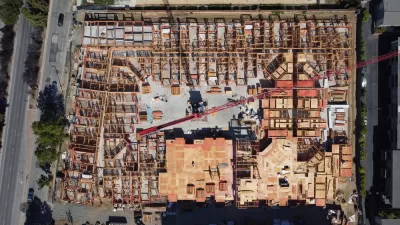Close to two-thirds of the region’s municipalities missed the October 15 deadline to revise their housing elements, jeopardizing state funds and control over local development.

The saga of California’s Regional Housing Needs Assessment (RHNA) continues, with nearly two-thirds of Southern California’s cities and counties failing to meet the deadline for updating their housing elements to satisfy state housing mandates.
As Jeff Collins reports for the Orange County Register, “As a result, the remaining 124 governments have two hurdles to overcome to get into compliance with state housing laws and avoid a host of possible sanctions,” namely getting a new housing element approved and rezoning enough parcels to meet their housing goals. “Governments without an approved housing plan and completed rezoning can lose access to state housing and transportation grants, have less control over future developments and face the risk of lawsuits and fines.” The Southern California city of Santa Monica saw 4,000 housing units proposed when it fell out of compliance with the state law earlier this year.
The RHNA requires cities and counties to revise their housing elements every eight years to account for population growth and ensure that housing supply meets demand. Formerly seen as rather toothless, the process garnered more attention this year when the state rejected many municipalities’ housing elements as unrealistic or insufficient and gave them an October 15 deadline for revising them.
As Collins explains, “The housing plans, which can run into hundreds of pages, outline where and how new housing can be built, creating an inventory of sites where developers can build new homes. Once the housing element is adopted, governments must rezone land to ensure there’s enough land for the new affordable and market-rate housing.”
Collins notes that “On the positive side, the 73 jurisdictions that won state approval represent 65% of the 1.3 million new housing units the state wants Southern California to build by 2030.” However, the needed housing in the jurisdictions without approved plans amounts to 474,210 new homes by 2030. Meanwhile, developers can use the “builder’s remedy” to get projects approved more easily in cities without approved housing elements.
FULL STORY: Most Southern California cities miss new deadline to complete housing plans

Alabama: Trump Terminates Settlements for Black Communities Harmed By Raw Sewage
Trump deemed the landmark civil rights agreement “illegal DEI and environmental justice policy.”

Study: Maui’s Plan to Convert Vacation Rentals to Long-Term Housing Could Cause Nearly $1 Billion Economic Loss
The plan would reduce visitor accommodation by 25% resulting in 1,900 jobs lost.

Planetizen Federal Action Tracker
A weekly monitor of how Trump’s orders and actions are impacting planners and planning in America.

Wind Energy on the Rise Despite Federal Policy Reversal
The Trump administration is revoking federal support for renewable energy, but demand for new projects continues unabated.

Passengers Flock to Caltrain After Electrification
The new electric trains are running faster and more reliably, leading to strong ridership growth on the Bay Area rail system.

Texas Churches Rally Behind ‘Yes in God’s Back Yard’ Legislation
Religious leaders want the state to reduce zoning regulations to streamline leasing church-owned land to housing developers.
Urban Design for Planners 1: Software Tools
This six-course series explores essential urban design concepts using open source software and equips planners with the tools they need to participate fully in the urban design process.
Planning for Universal Design
Learn the tools for implementing Universal Design in planning regulations.
Caltrans
Smith Gee Studio
Institute for Housing and Urban Development Studies (IHS)
City of Grandview
Harvard GSD Executive Education
Toledo-Lucas County Plan Commissions
Salt Lake City
NYU Wagner Graduate School of Public Service





























